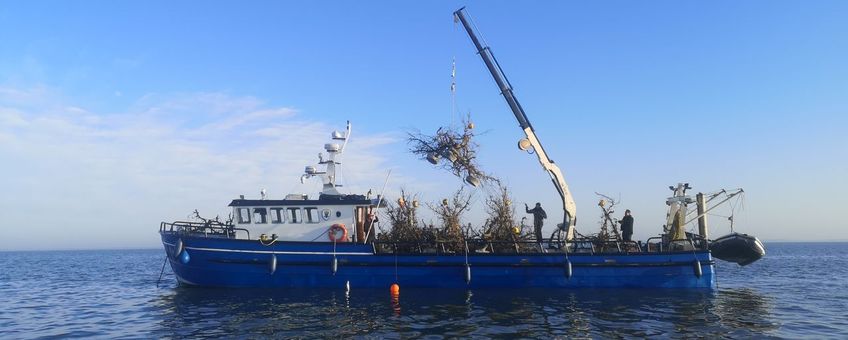
Restoring marine nature by planting fruit tree reefs
NIOZ Royal Netherlands Institute for Sea ResearchAdmittedly, placing trees at sea sounds a bit strange. And even if it is possible, why would you want to? To understand this, we should think of tropical reefs, according to Tjeerd Bouma - researcher at NIOZ, professor at Utrecht University and lecturer at HZ University of Applied Sciences in Vlissingen. "Everyone who thinks of a coral reef immediately thinks of lots of fish. You see the same thing around shipwrecks in the North Sea. This shows how important it is for fish to be able to hide well from hunters who want to eat them," says Bouma.
But how do you restore reefs? Inspired by bicycle trips in Zuid-Beveland, with its many orchards, Bouma came up with the idea of using cut-down, low-trunk fruit trees as TreeReefs. "In the Netherlands, we have about 100,000 hectares of orchards. Of these, approximately 250 hectares are cleared for new planting every year. These dead fruit trees are a natural by-product, with a complex reef structure of their own." There used to be a lot more washed-up trees in the Wadden Sea. So Bouma's idea doesn't sound so bad after all.

An experiment
But of course, an idea is still far from being an experiment. Fortunately, colleague Tjisse van der Heide, researcher at NIOZ and professor at Groningen University, saw an opportunity. "In the project 'Wadden Mosaic', we are looking for ways to strengthen the underwater nature. And this idea fitted in perfectly. With the help of the Wadden Foundation we have now started a unique experiment: a small TreeReef. PhD student Jon Dickson had to do a lot of testing to come up with a good design, because the dead trees have to stay solid on the seafloor. But everything is now in place, and it is super exciting to see what species of fish will swim in the TreeReef and what will grow on the branches.
The idea is appealing, which is why a small piece of TreeReef is also placed in the Grevelingenmeer in Zeeland. Less as an experiment, but mainly to inspire people. "Besides gaining scientific knowledge, it is important to show people what reefs can do to restore biodiversity," says Van der Heide.
Supporting biodiversity
"Although planting trees at sea sounds very strange, this approach fits well with our past," says Albert Oost of the State Forestry Service (Staatsbosbeheer). "In the past, there were many places with remains of trees on the bottom, both in the Wadden Sea, the Zuiderzee and the North Sea. That's why this experiment is very interesting: can it help to strengthen the underwater nature?"
"It could indeed be a good way to improve the biodiversity and fish diversity in areas such as the North Sea, Wadden Sea and Oosterschelde. And active nature development is crucial to make areas like the North Sea ready for the big challenges like climate change, huge areas of wind farms, sand extraction, and so on", says Gijs van Zonneveld of ARK Nature, an organisation that is actively involved in nature restoration. This is confirmed by Christiaan van Sluis from the The Rich North Sea programme: "The Dutch part of the North Sea alone is twice as large as the NetherLANDs we live in. The vast majority of the seabed is a sandy plain. Now that we are starting to designate protected areas, it would be great to plant some TreeReefs there right away. If only as an experiment to see what effect it has on marine life.”
 Ecological North Sea divers Karin Didderen and Wouter Lengkeek of Bureau Waardenburg have high expectations: "A TreeReef like this in the North Sea offers shelter for species such as sandy dogfish, cod, thornback ray, brown crab and European lobster. The trees will also function as a place to lay eggs for endangered species, such as sharks and rays and other special animals like squids. You will also see the growth of anemones and cold-water corals, and it will be teeming with species such as pout whiting and slugs.
Ecological North Sea divers Karin Didderen and Wouter Lengkeek of Bureau Waardenburg have high expectations: "A TreeReef like this in the North Sea offers shelter for species such as sandy dogfish, cod, thornback ray, brown crab and European lobster. The trees will also function as a place to lay eggs for endangered species, such as sharks and rays and other special animals like squids. You will also see the growth of anemones and cold-water corals, and it will be teeming with species such as pout whiting and slugs.
Scaling up towards the North Sea is exactly what researchers Bouma and Van der Heide are aiming for. "There, the discarded fruit trees can really become 'fruits de mer': reefs full of diversity and a valuable source of marine life".
Text: Royal Netherlands Institute for Sea Research (NIOZ)
Photos: Jon Dickson; Oscar Franken
